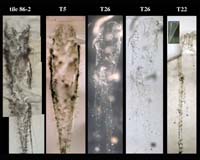 |
Los Angeles CA (SPX) Aug 21, 2009 Humans might not be walking on Earth today if not for the ancient fusing of two microscopic, single-celled organisms called prokaryotes, NASA-funded research has found. By comparing proteins present in more than 3000 different prokaryotes - a type of single-celled organism without a nucleus - molecular biologist James A. Lake from the University of California at Los Angeles' Center for Astrobiology showed that two major classes of relatively simple microbes fused together more than 2.5 billion years ago. Lake's research reveals a new pathway for the evolution of life on Earth. These insights are published in the Aug. 20 online edition of the journal Nature. This endosymbiosis, or merging of two cells, enabled the evolution of a highly stable and successful organism with the capacity to use energy from sunlight via photosynthesis. Further evolution led to photosynthetic organisms producing oxygen as a byproduct. The resulting oxygenation of Earth's atmosphere profoundly affected the evolution of life, leading to more complex organisms that consumed oxygen, which were the ancestors of modern oxygen-breathing creatures including humans. "Higher life would not have happened without this event," Lake said. "These are very important organisms. At the time these two early prokaryotes were evolving, there was no oxygen in the Earth's atmosphere. Humans could not live. No oxygen-breathing organisms could live." The genetic machinery and structural organization of these two organisms merged to produce a new class of prokaryotes, called double membrane prokaryotes. As they evolved, members of this double membrane class, called cyanobacteria, became the primary oxygen-producers on the planet, generating enough oxygen to alter the chemical composition of the atmosphere and set the stage for the evolution of more complex organisms such as animals and plants. "This work is a major advance in our understanding of how a group of organisms came to be that learned to harness the sun and then effected the greatest environmental change Earth has ever seen, in this case with beneficial results," said Carl Pilcher, director of the NASA Astrobiology Institute at NASA's Ames Research Center in Moffett Field, Calif., which co-funded the study with the National Science Foundation in Arlington, Va. Founded in 1998, the NASA Astrobiology Institute is a partnership between NASA, 14 U.S. teams and six international consortia. The institute's goals are to promote, conduct, and lead interdisciplinary astrobiology research; train a new generation of astrobiology researchers; and share the excitement of astrobiology with learners of all ages. The institute is part of NASA's Astrobiology Program in Washington. The program supports research into the origin, evolution, distribution and future of life on Earth and the potential for life elsewhere. Share This Article With Planet Earth
Related Links Astrobiology at NASA Life Beyond Earth Lands Beyond Beyond - extra solar planets - news and science
 Glycine In The Grid
Glycine In The GridGreenbelt MD (SPX) Aug 20, 2009 NASA scientists have discovered glycine, a fundamental building block of life, in samples of comet Wild 2 returned by NASA's Stardust spacecraft. "Glycine is an amino acid used by living organisms to make proteins, and this is the first time an amino acid has been found in a comet," said Dr. Jamie Elsila of NASA's Goddard Space Flight Center in Greenbelt, Md. "Our discovery supports ... read more |
|
| The content herein, unless otherwise known to be public domain, are Copyright 1995-2009 - SpaceDaily. AFP and UPI Wire Stories are copyright Agence France-Presse and United Press International. ESA Portal Reports are copyright European Space Agency. All NASA sourced material is public domain. Additional copyrights may apply in whole or part to other bona fide parties. Advertising does not imply endorsement,agreement or approval of any opinions, statements or information provided by SpaceDaily on any Web page published or hosted by SpaceDaily. Privacy Statement |